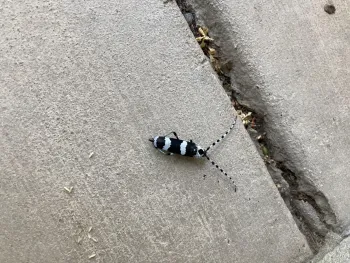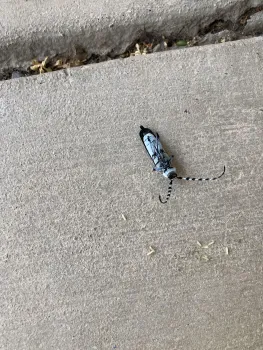Blog by Michelle Davis
Almost a month ago, I stepped out onto my patio to discover an insect I had never seen before. She was about 1 ½ inches long, not counting her long antennae. What was striking about her was the coloration: alternating bands of light blue and black, even on the antennae. Her entire underbelly was light blue. There were tiny rice-like grains near her. Since I had just cleaned the patio less than an hour earlier, and there was no wind, I guessed they were her eggs. Unfortunately, she appeared to be dying. Why, I can’t say, because the house hasn’t had insecticide used on it for over two years.

I used my phone to get some pictures. iNaturalist and the little bug icon that popped up on my photo’s “Siri knowledge” confirmed that I had found a Rosalia funebris, a species of beetle known as the Banded Alder Borer. With a name like that, the first inclination was that this was a “bad” bug, but this beauty is actually a “good” one. My next lookup was UC IPM. This insect is sometimes mistaken for the Asian longhorned beetle, but that bad boy beetle has a solid black thorax. Asian longhorned beetle larva chew their way through living hardwood trees all the way into the heartwood, eventually causing the tree’s death. An infestation requires quarantine and rapid removal of the trees, and UC IPM says that hundreds of thousands of trees have been cut down in the Northeast US to try to stop the spread.

Our Banded Alder Borers mate from April through August. The females usually lay their eggs on dying or newly dead branches of small to medium width. Those eggs hatch in about 2 weeks and grow into their larval stage, chewing their way under the bark for another 6 – 7 months. They only work on dead or dying branches. They bore deeper into the dead wood through the winter in their third stage as pupae. In spring, as adults now, they chew a hole out of the tree, and the cycle starts over. Their wood choice is not just alder, but also includes ash, maple, oak, sycamore, and willow. They were mostly found in the Pacific Northwest, but seem to be making their way across the country. They are an important part of the beetles that help in decomposition and ultimately into compost. These good insects do not need eradication.
They are also attracted to freshly painted objects. Does the paint act like a pheromone, or does dead/dying wood smell like fresh paint? No one seems to know. Since my house is being painted today, I’ll keep an eye out for them.

